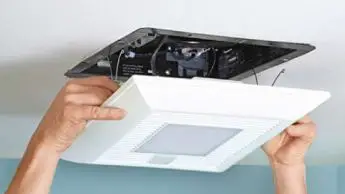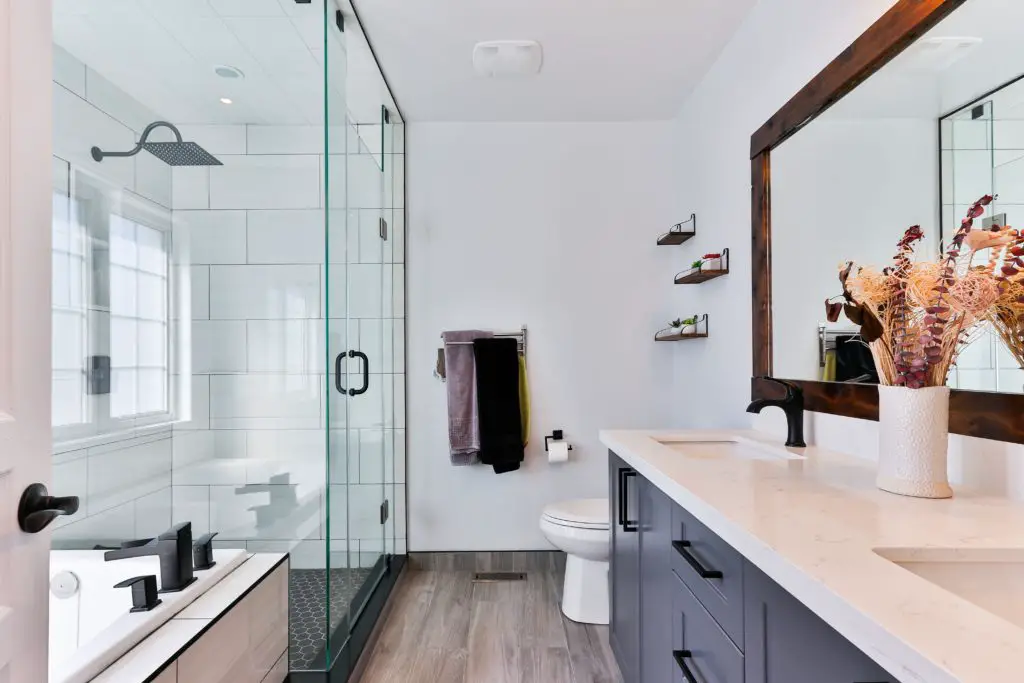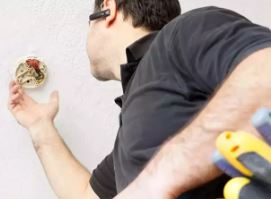Do you feel like your extractor fan stays on longer than it should? My bathroom extractor fan stays on for a pretty long time so I did some research to figure out how long an extractor fan should be on.
So how long should an extractor fan stay on for?
The minimum time an extraction fan timer will run for is 20 seconds and the maximum is approximately 20 minutes. Extractor fan timer controls are set by your installer and can be adjusted. They can be triggered on via a humidity sensor (which can also be adjusted) or light switch. The fan can have a separate switch as well.
Extractor fans are really important in removing moisture and humidity in bathrooms. They help to prevent mold too. Opening a window can only do so much. Since I was completely re-fitting my bathroom, it made sense to have one fitted, here are some ‘silly’ questions that I asked myself before I had it fitted.
How do I know if my Extractor Fan is Working/Needs Replacing?

The simplest way to check if your fan is working is actually to turn your fan on, get some tissue paper, one sheet will do, and check the ‘suction’. If it sticks pretty well, then great you don’t need to replace it.
If on the other hand, the tissue keeps falling down, then you may have a problem.
Another sign is if your extractor fan is especially loud or you can hear rattling noises. This may mean that the fan is overcompensating for something and could be a sign that it needs replacing.
The most likely cause of this will be a faulty motor. however, if your extractor fan is in the kitchen the fan can get a bit jammed if it gets greasy. A simple clean could fix it.
The life span of an extractor fan is 10+ years. Here’s a link to the exact fan I have (link to Amazon). Once fitted correctly you should have nothing to worry about, for a long time.
Is it OK to vent the bathroom Extractor fan into attic?

Venting an extractor fan directly into your attic is not recommended, and it’s particularly dangerous in the winter months. The excess moisture can build up inside your attic on the underside of your roof.
When it gets warmer the ice will melt onto your insulation and the bedroom walls. It can also cause rot on your wooden joists.
Fortunately, this is pretty fixable. You can vent outside of your attic. You just have to get an outdoor ventilation cap leading out of your roof installed.
Here’s an example called the Kair Bull nosed Vent (linked to Amazon) of the type of ventilation cap you should be looking for. What’s great about this one is the drip deflector and rubber seal to stop rainwater from getting into your home
To avoid all of this, If your bathroom has a window facing outside the best thing to do is to have the fan leading straight outside if you can.
Can a Bathroom Extractor Fan and Light be on the same switch?

Simply put, an extractor fan and your light switch can be on the same switch, I know because I have this set up in my home. When I pull my bathroom light cord, it triggers my extractor fan to come on.
It’s pretty handy, especially if you tend to forget to switch your extractor fan on or off.
Although I am game for most things DIY, when it comes to electrics, unless it’s super simple I tend to get an electrician involved. I would suggest that you do the same.
That said if you are interested generally in how it’s done, in a nutshell, you join together or ‘splice’ a series of complementary wires to your light switch and extractor fan. This is not the best explanation to be fair. For a more detailed walkthrough check out this article from hunker.com
Where should the Bathroom extractor fan be installed?

Bathroom extractor fans are most commonly installed in the following three ways:
- Through the ceiling with ducting going through the attic to an outside vent (as mentioned above)
- Directly through a wall to an external vent or using ducting to an external wall.
- Or through a window (not recommended). If you decide to change your extractor fan or change your window you will be restricting yourself.
Installing your extractor fan directly to an external wall is preferable as it’s the simplest installation and lowest maintenance option.
If you have to install your extractor fan directly through the ceiling then by all means go for it, just make sure that if your external vent is through your roof, it is properly sealed and you install a ventilation cap as mentioned above.
Do you need an electrician to fit a bathroom extractor fan?

Unless you are replacing an existing bathroom extractor fan, it makes sense to hire a licensed professional to do this particular job.
Installing a brand new extractor fan in a room with running water and moisture on a daily basis just has risks. Any electrical incident just is not worth it.
If however you are replacing a like for like extractor fan and all the major wiring and ducting is already in place, go for it.
As long as your new extractor fan has the same dimensions and similar functionality, you should be able to replace it yourself. It’s a simple DIY job, where you’re securing screws and attaching like-for-like wires.
Before you start though, make sure you check the existing wiring and ducting are in good shape. It’s the perfect time to change or replace them if you need to. Also, triple-check that the dimensions of your new fan line up with the holes of your old fan.
Why is my Bathroom Extractor Fan Constantly on?
If you have moved into a new home, the chances are that you have a pretty fancy extractor Fan. Mechanical ventilation fans provide constant air circulation, around the clock, i.e it never stops in order to maintain a level of air circulation in your home to a specified recommended flow rate.
It’s worth checking with a builder before you think something is wrong. These extractor fans are designed to use minimal electricity as well so you should not suffer too much on your bills.
Alternatively, if you do have an old extraction fan, your switch could be faulty. The best way to check is to take off the switch and replace it with a new one to see if the problems persist.
If it does persist, you should call your electrician as you may have a wiring problem.
What is the quietest extractor fan?
You can of course buy extractor fans that are quieter, so it’s generally less irritating when it’s turned on in the first place.
The Envirovent SIL 100T (linked to Amazon) is a good affordable option and the one I went for in my home. Firstly, it’s a good extractor fan, extracting 26 liters a second, which is actually awesome. Standard extractor fans extract between 15-20 liters per second, so this is great.
This is also one of the quietest fans in the market. It was awarded the Quiet Mark award in 2013.
Granted that this was some time ago, but with a sound output of Sound output: 26.5 dB (A), this is still super quiet.
This Xpel simply silent (linked to Amazon) fan is quieter at 16 dB (A) but can only extract 15 liters per second. For that reason, I’d still stick with the Envirovent SIL 100T.
In Summary…
When it comes to your fan staying on too long and the fan being too sensitive to humidity, this is largely dependent on the settings your installer would have set when setting up your fan. Check the manual of how to change this before you think something is wrong.
If you live in a new home and the fan is constantly on be sure to check what kind of a fan you have. It may be that the fan is supposed to be constantly in order to maintain a level of air circulation.
Extractor Fans are not just important for the circulation of your bathroom but also for the prevention of mold and moisture build-up too.
Installing one incorrectly ironically can lead to more mold and moisture build-up, so in this case, make sure you use a professional to initially install it if not already there.
If on the other hand, you are replacing an existing extractor fan, changing it should be a simple DIY job, as long as the dimensions and fixtures are like for like.
Extractor fans typically last for over 10 years, so before you think of replacing it, make sure you clean it of any grease, check with a piece of tissue paper up against the vent that it’s circulating air as well.
As far as external vents go, be sure to buy a vent to minimize the amount of water coming into your home.
Really hope you enjoyed reading this article guys. If you have any more DIY questions, be sure to check out some more of our content. We might have answered your question.
Happy DIYing guys!

